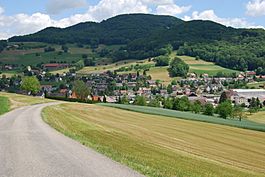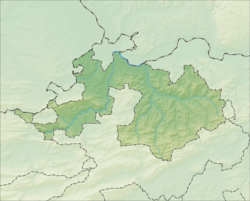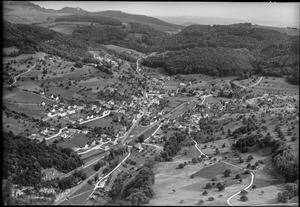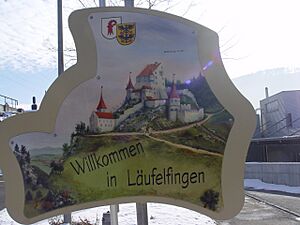Läufelfingen facts for kids
Quick facts for kids
Läufelfingen
|
||
|---|---|---|
 |
||
|
||
| Country | Switzerland | |
| Canton | Basel-Landschaft | |
| District | Sissach | |
| Area | ||
| • Total | 8.16 km2 (3.15 sq mi) | |
| Elevation | 560 m (1,840 ft) | |
| Population
(Jun 2021 )
|
||
| • Total | 1,252 | |
| • Density | 153.43/km2 (397.4/sq mi) | |
| Postal code |
4448
|
|
| Surrounded by | Buckten, Diegten, Eptingen, Häfelfingen, Hauenstein-Ifenthal (SO), Känerkinden, Wisen (SO) | |
Läufelfingen is a small town, also called a municipality, located in Switzerland. It's found in the Sissach district within the canton of Basel-Country. This charming place is known for its beautiful Swiss scenery.
Contents
History of Läufelfingen
Läufelfingen has a long history! It was first mentioned in official records way back in 1226. Back then, it was called Leinvolvingen. Later, in 1481, its name changed slightly to Leiffeldingen.
Geography and Landscape
Läufelfingen covers an area of about 8.15 square kilometers (that's about 3.15 square miles). A big part of this land, almost half (49.1%), is used for farming. About 41.2% of the area is covered by forests. The remaining 9.7% is where buildings and roads are located.
The town is nestled in the Sissach district. It sits along the Homburger stream and is also on the road that goes over the Unteren Hauenstein pass. Läufelfingen itself is a haufendorf village. This means it's an old-fashioned village that grew without a strict plan, with buildings packed closely around a central area.
Coat of Arms
The coat of arms for Läufelfingen is quite striking! It shows two black eagles with red tongues, beaks, and claws, on a golden background. This design is called Or, two Eagles displayed Sable, langued, beaked and membered Gules.
People and Population
Läufelfingen has a population of about 1,200 to 1,300 people. Most of the people living here speak German, which is about 93.3% of the population. Other languages spoken include Albanian (2.1%) and Italian language (1.6%).
About 9.5% of the people living in Läufelfingen are from other countries. Most residents are Swiss citizens. Many people (about 37.7%) were born right in Läufelfingen. Others were born in the same canton (20.1%) or elsewhere in Switzerland (29.5%). About 11.5% of the population was born outside of Switzerland.
The age groups in Läufelfingen are:
- Children (0-6 years old): 7.0%
- Teenagers (7-19 years old): 15.4%
- Young adults (20-29 years old): 9.8%
- Adults (30-49 years old): 29.2%
- Older adults (50-64 years old): 20.9%
- Seniors (65+ years old): 17.6%
Most households in Läufelfingen have an average of 2.5 people. About 28.5% of households are made up of just one person. Many homes (63.8%) are owned by the people who live in them, meaning they don't pay rent.
The historical population of Läufelfingen has changed over the years, as you can see in the chart below:

Important Heritage Sites
The old ruins of Neu-Homburg Castle are very important! They are listed as a Swiss heritage site of national significance. This means they are a protected historical treasure.
Homberg or Neu-Homberg Castle was once the home of the Froberg family. They lived there from the 13th century until the castle was destroyed in 1798.
Economy and Jobs
In Läufelfingen, people work in different types of jobs. In 2005, about 65 people worked in farming (the primary sector). Another 117 people worked in manufacturing and construction (the secondary sector). The largest group, 298 people, worked in services like shops, hotels, or healthcare (the tertiary sector).
Many people who live in Läufelfingen travel to other towns for work. About 419 people commute away from the municipality each day. About 206 people travel into Läufelfingen for their jobs. Most people get to work by private car (46.9%) or by public transportation (19.8%).
Religion in Läufelfingen
According to a census in 2000, most people in Läufelfingen belong to Christian churches. About 59.7% were part of the Swiss Reformed Church, and 17.2% were Roman Catholic. There were also smaller groups of other Christians.
Some people followed other religions, like Islam (4.64%). A small number of people (12.47%) said they didn't belong to any church or were agnostic or atheist.
Transportation
Läufelfingen is connected by train! It sits on the Hauenstein line. You can catch trains at the Läufelfingen railway station, making it easy to travel to and from the town.
Education
Education is important in Läufelfingen. About 42.4% of the population has completed upper secondary education, which is like high school. Also, about 9.4% of people have gone on to get higher education, either at a university or a specialized college.
In 2000, a few students (5) came to Läufelfingen to attend school. However, more students (96) from Läufelfingen went to schools in other towns.
See also
 In Spanish: Läufelfingen para niños
In Spanish: Läufelfingen para niños






